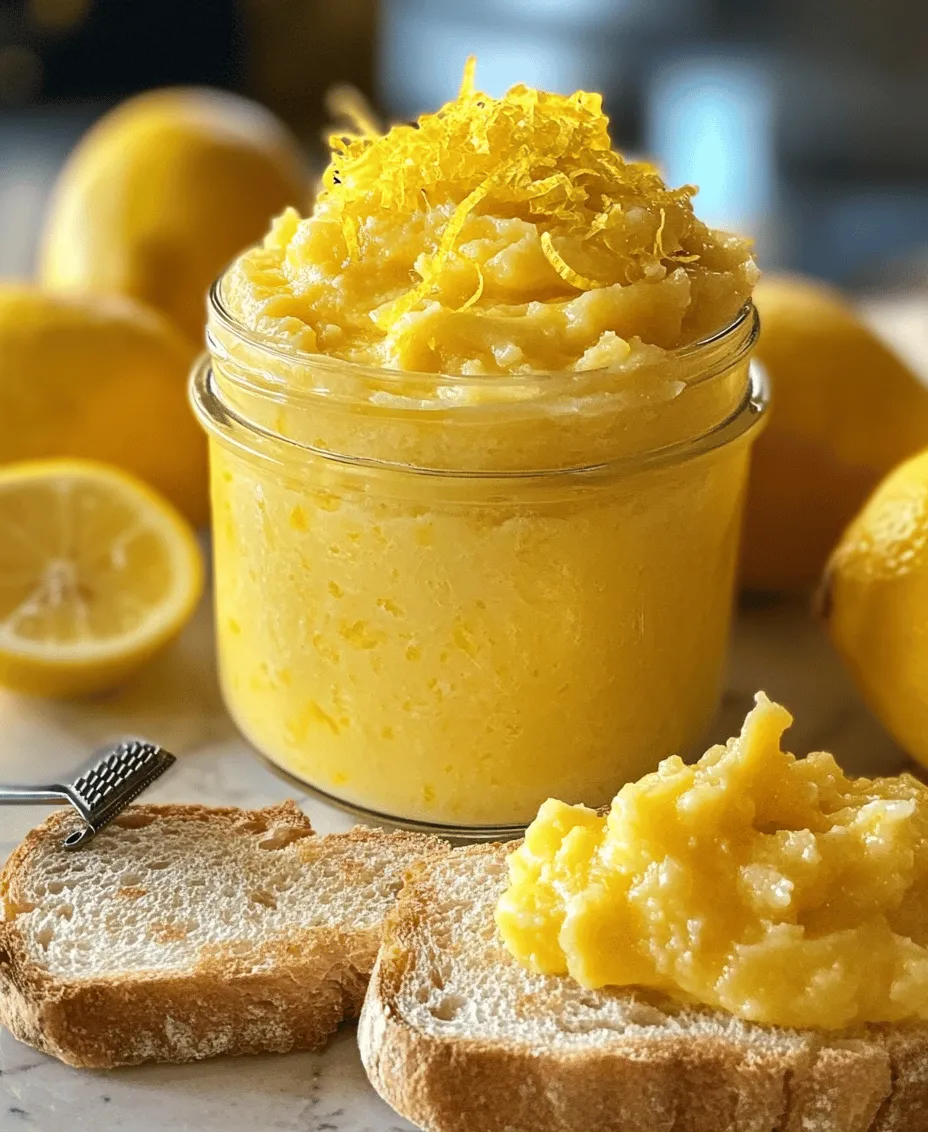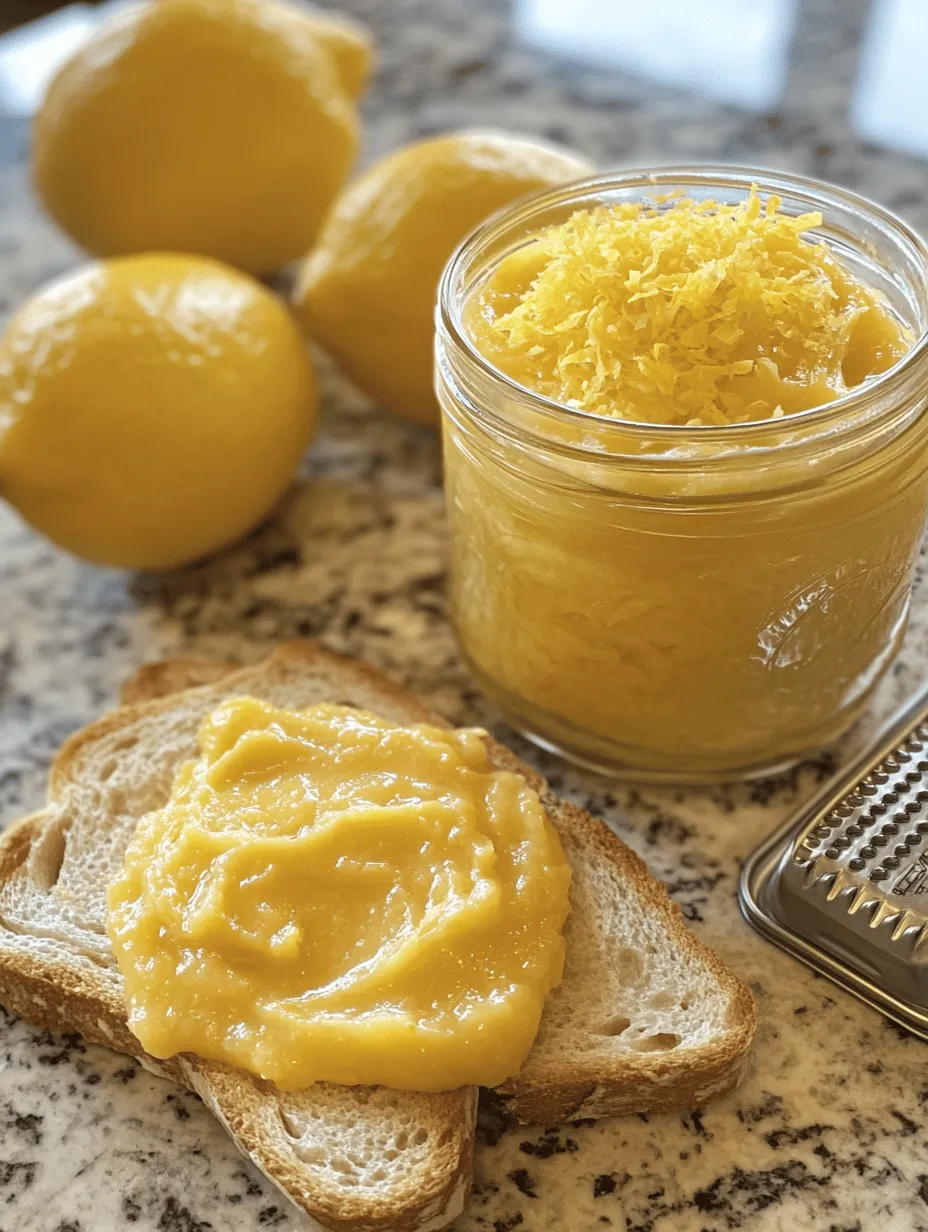Lemon curd is one of the culinary world’s hidden gems, known for its bright, tangy flavor and smooth texture. This delightful spread has gained popularity for its versatility, serving as a topping for scones, a filling for pastries, or a standalone treat that can elevate a simple dessert into something extraordinary. Among the various lemon curd recipes, the Zesty Lemon Curd Delight stands out for its refreshing taste and ease of preparation. Whether you’re looking for a light dessert to impress guests or a simple treat to enjoy at home, this recipe is sure to become a favorite.
The combination of fresh lemon juice and zest creates a flavor profile that is both zesty and sweet, making it a perfect addition to numerous desserts. The balance of acidity and sweetness in lemon curd enhances the overall taste of any dish, adding a vibrant touch that invigorates the palate. Not only is this Zesty Lemon Curd Delight easy to make, but it also allows for creative uses, whether as a filling for cakes, a topping for yogurt, or simply enjoyed by the spoonful.
Understanding Lemon Curd
Lemon curd is a sweet, tangy spread made from fresh lemons, sugar, eggs, and butter. Its origins can be traced back to 19th-century England, where it was originally served with bread as a breakfast item, much like jam. Over the years, lemon curd has transitioned from a breakfast staple to a beloved ingredient in various dessert recipes, cementing its place in modern culinary traditions.
The significance of lemon in culinary traditions is profound. Lemons have been used for centuries not only for their flavor but also for their health benefits. Rich in vitamin C, antioxidants, and dietary fiber, lemons can aid in digestion, boost the immune system, and promote healthy skin. When incorporated into lemon curd, these nutritional benefits remain intact, making it not only a delicious addition to your dessert repertoire but also a source of healthful nutrients.
Key Ingredients and Their Importance
Understanding the key ingredients that contribute to the Zesty Lemon Curd Delight is crucial for achieving the best results. Here’s a breakdown of each ingredient and why they matter in this recipe:
Fresh Lemon Juice
The star of the show is undoubtedly the fresh lemon juice. Using freshly squeezed juice instead of bottled lemon juice is essential for achieving the best flavor. Fresh lemon juice has a vibrant acidity that bottled versions often lack, which can result in a duller taste. The acidity of fresh lemons not only enhances the flavor of the curd but also helps in creating the perfect balance with the sweetness of the sugar.
Lemon Zest
Lemon zest is the outermost layer of the lemon peel, and it is packed with aromatic oils that contribute significantly to the flavor of lemon curd. The zest adds a depth of citrus flavor that complements the juice, making the curd even more refreshing. When zesting, it’s crucial to avoid the white pith beneath the yellow skin, as it can impart a bitter taste. A microplane or a fine grater works best for zesting, allowing you to capture only the fragrant yellow skin.
Granulated Sugar
Sugar plays a vital role in balancing the tartness of the lemon juice. It not only sweetens the curd but also helps in creating a smooth texture when combined with the other ingredients. The right amount of sugar is essential to ensure the curd is not overly tart, making it palatable for all.
Eggs
Eggs are the magic ingredient that thickens the lemon curd. Their proteins coagulate during the cooking process, transforming the liquid mixture into a luxurious, creamy custard. The eggs also contribute to the overall richness of the curd, enhancing its mouthfeel.
Unsalted Butter
Butter adds a luscious richness to the curd and helps to give it a silky texture. Using unsalted butter is important in controlling the overall flavor of the curd, allowing you to adjust the saltiness to your taste. The butter should be added at the end of the cooking process to ensure it melts smoothly into the mixture, creating a glossy finish.
Salt
While it may seem counterintuitive to add salt to a sweet recipe, a pinch of salt is crucial for flavor enhancement. Salt balances the sweetness and acidity, elevating the overall taste of the lemon curd.
Preparation Steps in Detail
Preparing your Zesty Lemon Curd Delight begins with gathering the necessary tools and ingredients. Here’s a detailed explanation of the preparation steps to ensure your curd turns out perfectly.
Preparing the Zest and Juice
1. Zesting the Lemons: Start by washing the lemons thoroughly to remove any wax or pesticides. Using a microplane or a fine grater, zest the lemons carefully, avoiding the white pith beneath the skin. Aim for about 2 tablespoons of zest, which will provide that vibrant flavor.
2. Juicing the Lemons: After zesting, cut the lemons in half and juice them using a citrus juicer or a fork. Strain the juice through a fine mesh sieve to remove any seeds or pulp. You will need approximately ½ cup of fresh lemon juice for the curd, so adjust the number of lemons accordingly.
Tools Needed for Preparation
To make the Zesty Lemon Curd, you will require the following kitchen tools:
– Microplane or fine grater for zesting
– Citrus juicer for juicing
– Fine mesh sieve for straining the juice
– Mixing bowl for combining ingredients
– Saucepan for cooking the curd
– Whisk for mixing
– Heatproof spatula or wooden spoon for stirring
– Jar or container for storing the finished curd
With your ingredients prepped and tools ready, you’re well on your way to creating a delightful Zesty Lemon Curd that will impress anyone who tastes it. In the following sections, we will delve into the step-by-step instructions for cooking the curd and tips for achieving the perfect consistency. Whether you’re a seasoned chef or a novice in the kitchen, this recipe will guide you through the process with ease, ensuring a delicious outcome every time.

Combining Ingredients
To begin making your zesty lemon curd, gather your pre-measured ingredients: fresh lemon juice, lemon zest, granulated sugar, eggs, and a pinch of salt. In a medium mixing bowl, combine the lemon juice, lemon zest, sugar, and salt. Using a whisk, mix these ingredients until they are well combined and the sugar starts to dissolve. This initial step is crucial because it allows the vibrant flavors of the lemon to infuse into the sugar, creating a base that is both tart and sweet.
Importance of Thorough Mixing for a Smooth Curd
Thorough mixing is vital for achieving a smooth texture in your lemon curd. If the ingredients are not adequately combined, you may end up with lumps of sugar or unblended egg yolks in your final product. Take your time to whisk vigorously, making sure to scrape the sides and bottom of the bowl to ensure that no ingredient is left unmixed.
Tips for Ensuring No Visible Egg Yolk
One common challenge when making lemon curd is achieving a uniformly smooth mixture without visible egg yolks. To prevent any lumps, consider using a fine-mesh strainer to sift the egg yolks after you crack them into the bowl. Additionally, whisking the mixture vigorously can help break down any clumps of egg. If you find that your mixture still has visible bits of yolk after whisking, you can strain it before cooking to ensure a silky-smooth curd.
Heating the Mixture
Once your ingredients are well combined, it’s time to transfer them to a saucepan. Place the saucepan over low to medium heat. As the mixture heats up, it will begin to thicken, which is the key to a successful lemon curd.
Explanation of the Thickening Process and Desired Temperature
The thickening process occurs as the proteins in the eggs coagulate, which happens around 170°F (77°C). It is essential to monitor the temperature carefully; if it exceeds 180°F (82°C), the eggs may scramble, ruining the smooth consistency of your curd. A kitchen thermometer can be a handy tool here, allowing you to precisely gauge the temperature and avoid any mishaps.
Importance of Constant Stirring to Prevent Curdling
During heating, constant stirring is critical. Use a spatula or wooden spoon to stir the mixture continuously, ensuring that it doesn’t stick to the bottom of the pan and burn. This process also helps distribute heat evenly throughout the mixture, reducing the chances of curdling. The goal is to create a custard-like consistency, which can take approximately 10-15 minutes of stirring.
Adding the Butter
Once your mixture has reached the desired thickness, it’s time to add the butter. Remove the saucepan from the heat and cut the butter into small pieces.
Step-by-Step Guide on Incorporating Butter into the Mixture
1. Remove from Heat: Take the saucepan off the burner to stop the cooking process.
2. Add Butter: Gradually add the butter pieces to the hot curd mixture, a few at a time.
3. Stir Until Melted: Use your spatula to stir continuously until each piece of butter is completely melted before adding more.
4. Mix Well: Once all the butter has been incorporated, continue to stir for another minute to ensure a uniform texture.
Explanation of How Butter Affects Texture and Flavor
Butter plays a crucial role in the final outcome of your lemon curd. Not only does it add a rich, creamy texture, but it also enhances the flavor, balancing the tartness of the lemon. The fat in the butter creates a luscious mouthfeel, making each spoonful of curd a delightful experience.
Straining the Curd (Optional)
After adding the butter, you may choose to strain the curd for an ultra-smooth finish.
Benefits of Straining for a Smooth Consistency
Straining the curd through a fine-mesh sieve removes any small bits of cooked egg or lemon zest, resulting in a velvety texture. This step is particularly recommended if you’re planning to use the lemon curd in delicate desserts or pastries where texture matters.
When to Skip This Step for Added Texture
If you prefer a bit more texture in your lemon curd, feel free to skip the straining step. Leaving in the zest will provide a burst of flavor and a visually appealing speckled effect. This is especially delightful when serving the curd as a spread or topping.
Cooling and Storing
After you’ve prepared the lemon curd, let it cool in the saucepan for about 10 minutes. Then, transfer it to a clean jar or airtight container.
Tips for Cooling Effectively
To cool the curd quickly, you can place the jar in a bowl of ice water. This method helps bring the temperature down without compromising the curd’s texture. Be sure to stir occasionally to prevent a skin from forming on the surface.
Best Practices for Storage and Shelf Life
Once cooled, seal the jar and store it in the refrigerator. Homemade lemon curd can last up to two weeks in the fridge. For longer storage, consider freezing the curd. It can be frozen for up to three months. To defrost, simply transfer it to the refrigerator overnight.
Serving Suggestions for Zesty Lemon Curd
Lemon curd is incredibly versatile, making it an excellent addition to various dishes. Here are some creative serving suggestions to elevate your culinary experience.
Spread on Toast or Scones
One of the simplest yet most delightful ways to enjoy lemon curd is as a spread on warm toast or freshly baked scones. The sweet and tangy flavor of the curd pairs beautifully with a cup of tea or coffee, making it an ideal breakfast or brunch option.
Ideas for Breakfast or Brunch Pairings
Consider serving lemon curd alongside a selection of breakfast pastries, such as croissants or muffins. It can also be a delicious addition to pancakes or waffles, adding a zesty twist to your morning routine.
Filling for Tarts and Cakes
Lemon curd can be used as a filling for various desserts, adding brightness and flavor.
Inspiration for Desserts Featuring Lemon Curd
Try layering lemon curd in a tart shell, topped with fresh berries for a stunning dessert. You can also use it as a filling in cakes or cupcakes, complementing it with a light whipped cream frosting.
Topping for Yogurt or Ice Cream
For a refreshing treat, consider dolloping lemon curd over yogurt or ice cream. The tartness of the curd cuts through the creaminess, providing a balanced flavor profile. This combination can make for a simple yet elegant dessert.
Creative Ways to Incorporate Lemon Curd into Everyday Treats
Additionally, you can swirl lemon curd into smoothies or use it to flavor homemade popsicles, creating a refreshing summer treat.
Other Culinary Uses
Lemon curd isn’t just for sweet dishes; it can also be a unique addition to savory recipes.
Unique Applications in Savory Dishes or Cocktails
Consider using lemon curd as a glaze for roasted chicken or fish, adding a citrusy zing to your meal. You can also incorporate it into cocktails, pairing it with gin or vodka for a refreshing drink.
Conclusion
Making homemade lemon curd is a rewarding culinary experience that brings the vibrant flavors of citrus into your kitchen. The process, while needing care and attention to detail, results in a delightful product that can enhance a variety of dishes. Whether you choose to spread it on your morning toast, use it as a dessert filling, or even incorporate it into savory dishes, lemon curd is sure to impress.
Don’t hesitate to experiment with your own variations—add herbs, spices, or different citrus fruits to create a unique flavor profile. Embrace the joy of making this delightful recipe and discover how easily it can elevate your culinary repertoire.

